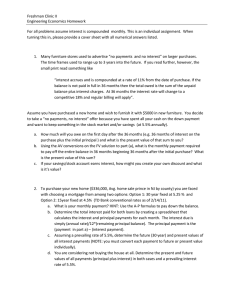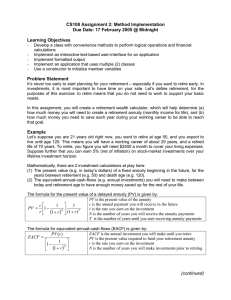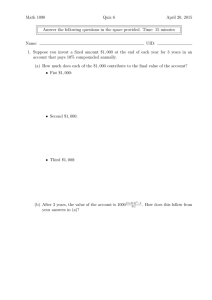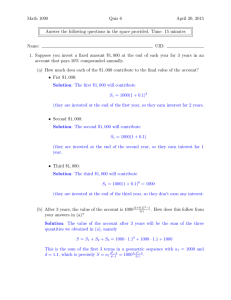Backgrounder on Time Value of Money CASH IS KING
advertisement
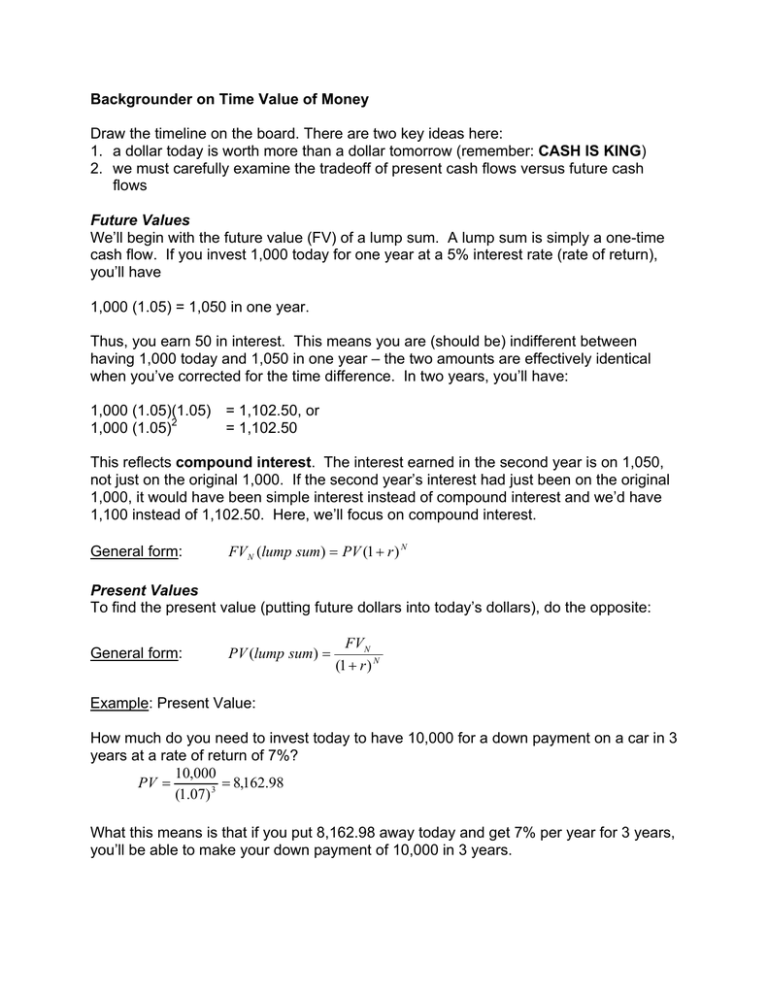
Backgrounder on Time Value of Money Draw the timeline on the board. There are two key ideas here: 1. a dollar today is worth more than a dollar tomorrow (remember: CASH IS KING) 2. we must carefully examine the tradeoff of present cash flows versus future cash flows Future Values We’ll begin with the future value (FV) of a lump sum. A lump sum is simply a one-time cash flow. If you invest 1,000 today for one year at a 5% interest rate (rate of return), you’ll have 1,000 (1.05) = 1,050 in one year. Thus, you earn 50 in interest. This means you are (should be) indifferent between having 1,000 today and 1,050 in one year – the two amounts are effectively identical when you’ve corrected for the time difference. In two years, you’ll have: 1,000 (1.05)(1.05) = 1,102.50, or 1,000 (1.05)2 = 1,102.50 This reflects compound interest. The interest earned in the second year is on 1,050, not just on the original 1,000. If the second year’s interest had just been on the original 1,000, it would have been simple interest instead of compound interest and we’d have 1,100 instead of 1,102.50. Here, we’ll focus on compound interest. General form: FV N (lump sum) = PV (1 + r ) N Present Values To find the present value (putting future dollars into today’s dollars), do the opposite: General form: PV (lump sum) = FV N (1 + r ) N Example: Present Value: How much do you need to invest today to have 10,000 for a down payment on a car in 3 years at a rate of return of 7%? 10,000 PV = = 8,162.98 (1.07) 3 What this means is that if you put 8,162.98 away today and get 7% per year for 3 years, you’ll be able to make your down payment of 10,000 in 3 years. Annuities Annuities are cash flows that repeat for several periods, but the payments eventually stop. an annuity is a constant cash flow for a finite number of periods. for now, let the first payment be one period from now. This is an ordinary annuity. examples include car payments, mortgage payments, rents, settlement payments, periodic investments… PV (annuity ) = 1 c c 1 c − = − 1 r r (1 + r )N r (1 + r )N Example: suppose RJR/Nabisco has to pay Massachusetts 10 million (10 MM) per year for the next 20 years in damages for the tobacco lawsuit. The first payment is in one year. If r = 9%, what’s the value in today’s dollars of this stream of cash flows? PV (annuity ) = 10 MM 0.09 1 = 91.29 MM 1 − 20 ( ) 1 . 09 Equivalent Annual Cash Flows The EACF is basically the annuity formula re-arranged to solve for the annual payment: EACF = PV (r ) 1 1 − N (1 + r ) Retirement Planning Now that we have a basic understanding of present values and annuities, here’s how it can apply to retirement planning. Example: Let’s suppose you are 21 years old right now, you want to retire at age 50, and you expect to live until age 120. This means you will have a working career of about 29 years, and a retired life of 70 years. To retire, you figure you will need $2500 a month to cover your living expenses. Suppose further that you can earn 5% (net of inflation) on stock-market investments over your lifetime investment horizon. How much money do you need to save for retirement? The present-value of the annuity you want to receive down the road. How do you save that much “present value”? By making regular annual investments over the course of your working career. Mathematically, there are 2 investment calculations at play here: (1) The present value (e.g. in today’s dollars) of a fixed annuity beginning in the future, for the years between retirement (e.g. 50) and death age (e.g. 120). • • • Future Annuity Payment = $2500 per month $30,000 per year Payments go for 70 years Rate of return is 5%. 1 30,000 1 c = PV (annuity ) = 1 − 1 − = 600,000[0.96714] = $580,280.30 N 0.05 (1.05)70 r (1 + r ) This amount ($580,280) seems huge, but remember it future dollars – the retirement annuity payments start 29 years from now. To bring back to today’s dollars (draw timeline): FV N $580,280.30 PV (lump sum) = = = $140,976.96 N (1 + r ) (1.05) 29 Now, how do you go about saving $140,976.96? (2) The equivalent-annual-cash-flows (e.g. annual investments) you will need to make between today and retirement age to have enough money saved up for the rest of your life. • • • You need to raise $140,976.96 (of today’s dollars). You have 29 years to save for retirement. Rate of return is 5%. EACF = PV (r ) 1 1 − N (1 + r ) = 140,976.96(0.05) 7,048.85 = = 9,310.90 0.757 1 1 − 29 (1.05) The bottom line: you need to start saving $9,310 per year, or about $776 per month, starting as soon as you get your first job. If you earn $40,000 per year, this means about 23.3% of your income. This sounds like a lot, but actually it’s a good deal. • time is one your side • the government lets you invest for retirement before paying taxes • If you really want to save less per month, you could work to age 60 – how much do you need to save per month in that case? $4,977 per year • What about if you want to retire earlier? Age 45? $13,135 per year.
